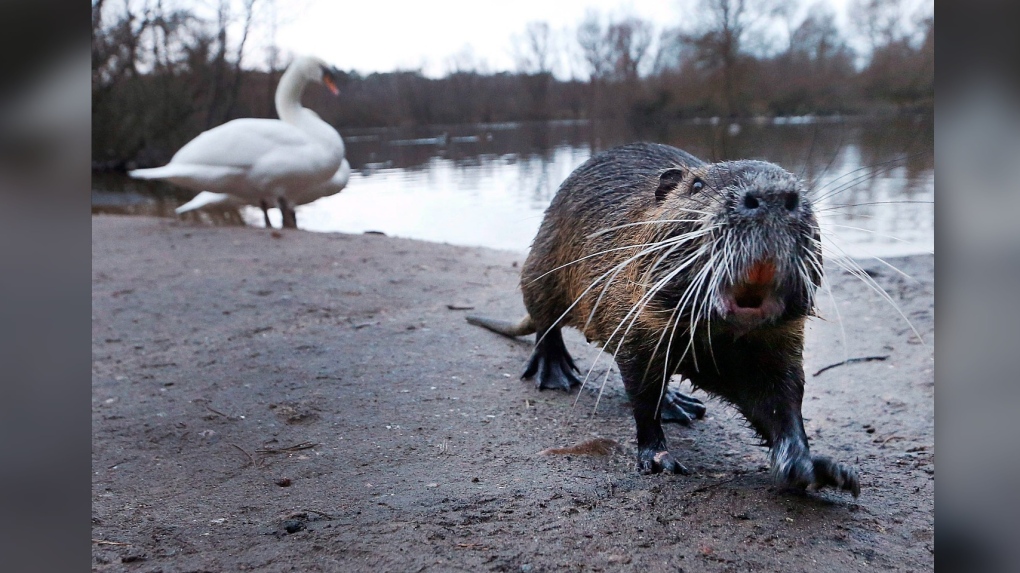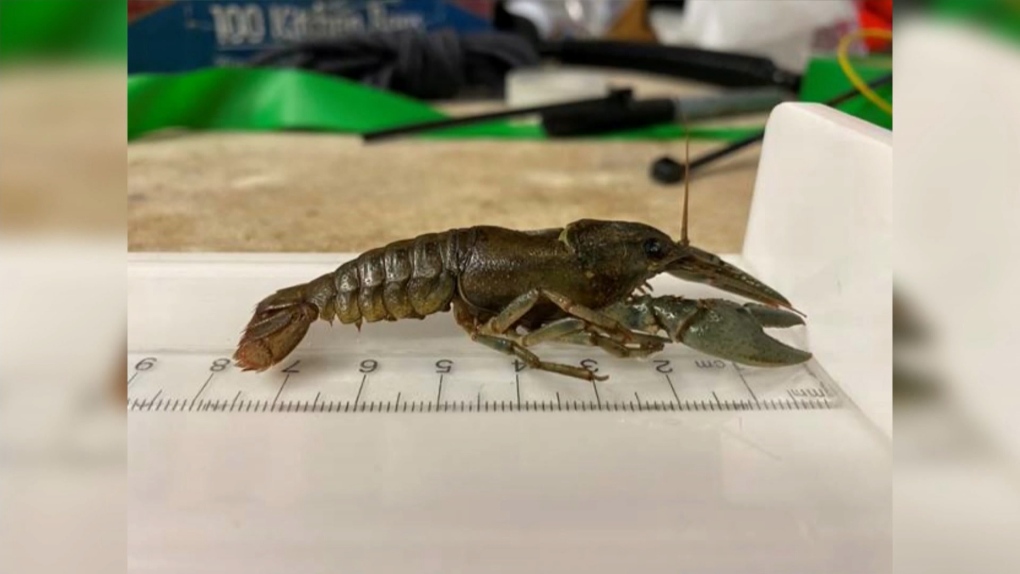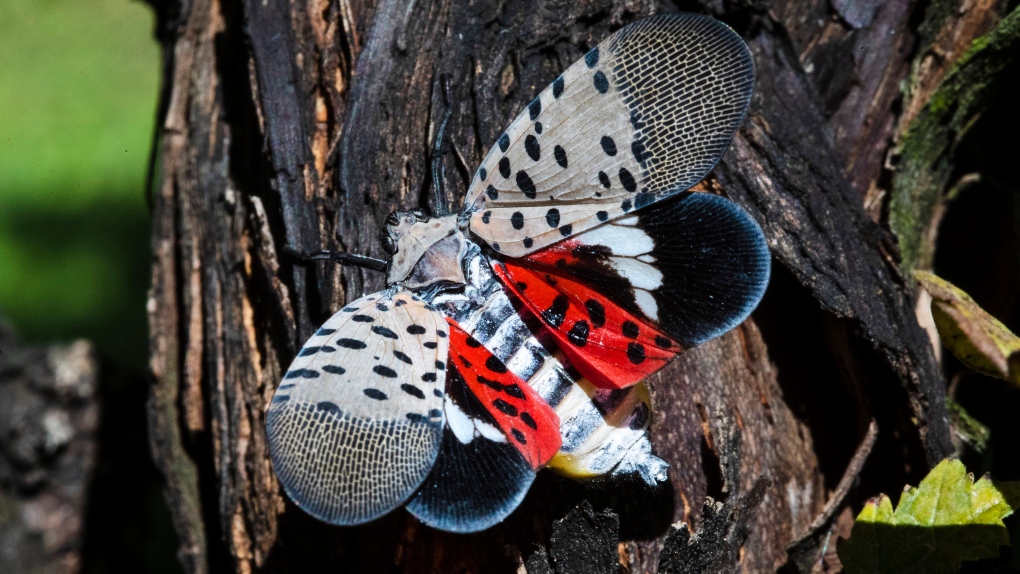A look at the new additions to Ontario's invasive species list
 A semi-aquatic herbivore called a nutria is the only mammal on the province’s updated invasive species list, which came into effect on Jan. 1.
A semi-aquatic herbivore called a nutria is the only mammal on the province’s updated invasive species list, which came into effect on Jan. 1.
A large rodent from South America that officials say is often mistaken for a beaver along with two types of non-native crayfish are among 10 new invasive animal and plant species now prohibited or restricted in Ontario.
A semi-aquatic herbivore called a nutria, whose name in Latin (Myocastor coypus) translates to “mouse rat,” is the only mammal on the province’s updated invasive species list, which came into effect on Jan. 1.
According to the Ministry of Natural Resources and Forestry, the nutria poses a threat to the local ecosystem as its burrowing and foraging behaviour – essentially punching holes into stream banks and wetlands and nibbling on roots – significantly impacts agricultural areas and may increase flooding risks. It can also spread parasites and disease to humans, pets, and livestock.
- Download our app to get local alerts on your device
- Get the latest local updates right to your inbox
Nutrias measure approximately two feet in length and weigh up to 20 pounds with a long tail, white whiskers, and large front teeth.
Colin Cassin, policy manager for the Invasive Species Centre, told CP24.com that the nutria was first introduced to the United States back in 1899 and was farmed in captivity for its fur until about 1940 when demand declined to the point that this industry was no longer profitable.
Many nutrias were then released into the wild and began to rapidly reproduce.
They are now present in at least 20 U.S. states, including Massachusetts, Illinois, and Washington, but haven’t yet been spotted in Ontario.
“Fast forward 50, 60, 70 years and here we are dealing with an emerging invasive species issue,” Cassin said.
He also pointed to two types of crayfish, Genus Procambarus and Genus Pacifastacus, which have also been added to the list of invasive species in Ontario.
These kinds of crayfish, which reproduce by cloning, compete with local ones as well as fish species for food and shelter. They are also known to burrow into the banks of wetlands and cause significant damage.
In North America, there is only one known wild population of marbled crayfish (Procambarus) in Burlington, Ont.
“(Nutrias and crayfish) are very different, but they’re both being regulated because they have similar impacts,” Cassin said, adding while the province’s wetlands are key spots for biodiversity, they’re facing a number of notable stressors.
The extra impacts of invasive species only makes it harder for these sensitive ecosystems to thrive, he explained.
 Under provincial regulations, crayfish are listed as an aquatic invasive species of concern throughout Alberta. Bill Macfarlane reports.
Under provincial regulations, crayfish are listed as an aquatic invasive species of concern throughout Alberta. Bill Macfarlane reports.
Three kinds of fish have been placed on the province’s list of prohibited invasive species. They include ide, which can introduce parasites, virus and disease transmission, and compete with native fishes; eastern and western mosquito fishes, which can outcompete native fish species for food and habitat through aggressive feeding of zooplankton, eggs and larvae, leading to the loss of biodiversity and potential loss of some native species in Ontario; and red shiner, which can reduce native fish populations through predation on eggs and larvae, genetic impacts through hybridization, and introduction of parasites.
There are also two new prohibited aquatic plants in Ontario: oxygen weed and Genus Salvinia (watermoss). In both cases, their dense colonies can outcompete native vegetation as well as fish populations, adversely affect water quality, and impede recreational activities like boating and swimming.
According to the Ontario Invasive Species Act, it is illegal to import, possess, deposit, release, transport, propagate (breed/grow), buy, sell, lease or trade the aforementioned invasive species.
Ontario has also announced that it is imposing restrictions, also effective Jan. 1, on four types of aquatic plants: Eurasian Water-milfoil, Floating Primrose-willow, Flowering-rush, and Genus Azolla (Water Ferns) as well as one terrestrial plant called Tree-of-heaven.
These plants can cause a range of negative outcomes on the local ecosystem, including outcompeting native vegetation, adversely affecting water quality, impeding recreational activities like boating and swimming, creating habitat for mosquitoes, displacing native riparian vegetation, forming dense stands that impact industrial and recreational uses of shallow waters, reducing the habitat of native fish/increasing the habitat for invasive fish, and negatively affecting wild rice populations.
The Tree-of-life is especially of concern, said Cassin, as it can change the chemical and microbial activity in soils, reduce soil nutrients, and displace native plant species. It is also associated with several fungal pathogens and is the preferred host for the spotted lanternfly (Lycorma delicatula). Infestations of this insect, he said, have been known to devastate grape, hops, and fruit crops. The nearest known lanternfly population is in Buffalo, N.Y.
 This Sept. 19, 2019, file photo shows a spotted lanternfly at a vineyard in Kutztown, Pa. (AP Photo/Matt Rourke)
This Sept. 19, 2019, file photo shows a spotted lanternfly at a vineyard in Kutztown, Pa. (AP Photo/Matt Rourke)
It is illegal in Ontario to deposit or release restricted invasive species. They are also prohibited from being placed into a provincial park or conservation reserve.
The ultimate goal of restricting or prohibiting certain non-native animals and plants is to prevent, control, and reduce their spread and the harmful effects they may cause.
It can also be both difficult and costly to control or eradicate non-native species once they’ve taken root in the ecosystem.
It is estimated that municipalities and conservation authorities in Ontario spend $51 million a year to prevent and manage the spread of manage invasive species. The Emerald Ash Borer infestation, which was first detected in the province in 2002, was especially costly to control and continues to this day albeit at a lesser rate, Cassin said.
“Invasive species damage our ecosystems, impact our ability to enjoy outdoor activities and harm our economy by threatening the forestry and agriculture sectors,” Graydon Smith, Minister of Natural Resources and Forestry, said in a Dec. 11 news release.
“That’s why we are taking action to restrict these invasive species to protect Ontario’s economy and ecosystems.”
Ontario has the highest number of invasive species and/or carriers of them in the country and since 2015 has placed legal restrictions or prohibitions on almost 50 of them.
CTVNews.ca Top Stories

Driver who entered Canada 'without stopping' at B.C. border crossing arrested: police
A man who illegally blew through the Canada-U.S. border crossing in Surrey, B.C., Sunday morning has been arrested, according to authorities.
Man responsible for New Year's truck attack previously visited New Orleans, Ontario, Egypt: FBI
The man responsible for the truck attack in New Orleans on New Year's Day that killed 14 people visited the city twice before and recorded video of the French Quarter with hands-free glasses, an FBI official said Sunday.
'Absolutely devastating': Southern Manitoba golf course clubhouse burns for second time in 4 years
A golf course clubhouse in Morden, Man. went up in flames Sunday for the second time in less than four years, and mere days after its reopening from the previous fire was celebrated.
Thousands are without power due to winter storm hitting Newfoundland and Labrador
Massive waves slammed Newfoundland and Labrador's coastline on Sunday, as a powerful winter storm left thousands without power.
Pamela Anderson, Ryan Reynolds among Canadians vying for Golden Globes tonight
Tonight’s Golden Globes will feature a strong Canadian presence, with British Columbia actors Pamela Anderson and Gabriel LaBelle among the first-time nominees.
The Vivienne, star of 'RuPaul's Drag Race UK', dies at 32
British reality show 'RuPaul's Drag Race UK' winner James Lee Williams, aged 32, popularly known as The Vivienne, has died.
Driving into Manhattan? That'll cost you, as new congestion toll starts Sunday
New York’s new toll for drivers entering the center of Manhattan debuted Sunday, meaning many people will pay US$9 to access its busiest part in peak hours.
WATCH Woman critically injured in explosive Ottawa crash caught on camera
Dashcam footage sent to CTV News shows a vehicle travelling at a high rate of speed in the wrong direction before striking and damaging a hydro pole.
Heaviest snowfall in a decade possible in some areas as winter storm threatens U.S.
A blast of snow, ice, wind and plunging temperatures stirred up dangerous travel conditions in parts of the central U.S. on Sunday, as a disruptive winter storm brought the possibility of the 'heaviest snowfall in a decade' to some areas.

































